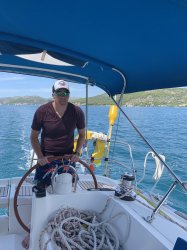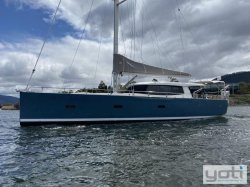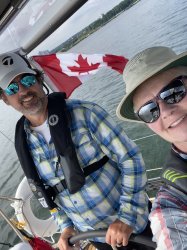
Student
Charles Brown
St. Francis, WI, USA
More User info
Skipper (small keelboat) Level IV
Status: Sailor
Qualified days: 169
Posted 2019, Nov 14 18:07
coordinates given in the questions do not match what the chart plotter shows. why is this?

Student
Aaron Sandler
Victoria, BC, Canada
More User info
Captain Level III
Status: Big Time Sailor
Qualified days: 85
Posted 2019, Dec 12 19:43
I’m looking at the TVMDC table on this page’s example and all of the Deviations are listed as 3W, which is not what the deviation table says...this looks like an error that should be fixed, no?

Student
Mark Bartusch
OKLAHOMA CITY, OK, USA
More User info
Captain Level IV
Status: Big Time Sailor
Qualified days: 148
Posted 2020, Jan 19 23:11
The statement: "Slack Water: Times when the water movement due to tidal effects are minimal. Note that because of the time it takes for bays and estuaries to drain out, slack water is not necessarily at high tide and low tide. Consult current tables to learn slack water times."
The above threw me off the answer of a question on quiz. Meaning that Slack Water does usually occur during high tide and low tide, just not at all places. I mention this for those, like me, that would misunderstand such a statement.

Student
Bill Griffith
Long Beach, CA, USA
More User info
Skipper Large Sailboat Level IV
Status: Big Time Sailor
Qualified days: 126
Posted 2020, May 02 16:12
In the example you explained the problem of anchoring at low tide. Am I correct in assuming that anchoring at high tide would leave you with too much rode as the tide dropped, causing excessive swing & the same problem of crashing?

Student
David Rinehart
Charlottesville, VA, USA
More User info
Crew Level 0
Status: Sailor
Qualified days: 2
Posted 2020, Jun 14 02:38
47th Ed, Dec 2018 / Last Correction 4/17/2020 has no Stone Reef label, Fl 2.5s 22ft 7M (not 36ft), icon for a lighthouse with riprap. I suppose the Fl 2.5s is the giveaway, presumably they try not to change that even if names and heights change.

Student
Benjamin Boulnois
Saint Germain en Laye, Yvelines, France
More User info
Qualified Crew Member Level I
Status: Sailor
Qualified days: 13
Posted 2020, Jun 28 14:06
I am not sure how the answer for the tidal flow was HW + 1/2 and not 1hr. I reviewed the Almanac but clearly I missed something. Apologies if I am asking a basic question.

Student
Bryce Larson
Seymour, IN, USA
More User info
Skipper Small Sailboat Level II
Status: Sailor
Qualified days: 30
Posted 2020, Aug 15 21:45
Excellent question, adding some feedback to dated post. The case of applying 2 HW/LW interpolation lines is depicted on the additional exercises PDF#2 (fictitious port, 09Sep, solve safe time to traverse >= 1.5m tide). A case for treatment of the Mixed Semidirunal tides and graphed "ebbing" vs "flooding" solution determination. Excellent discussion @NauticEd ANSWER in related 09Sep additional example.
Above student question seems valid & applicable to use 2 different HW/LW interpolation lines to be most accurate 'before' HW at flooding tide.
Question pertaining [LW -5h] placed together under graph Tide Curve Shape is possibly a publishing error throughout blank PDF curves of this chapter. Unlike illustrated After HW [+5h] & [LW] shown separate grid spaces.

Student
David Egles
Victoria, BC, Canada
More User info
Captain Level V
Status: Really Big Time Sailor
Qualified days: 239
Posted 2020, Sep 22 15:39
I was trying to follow the example of a journey from Namley Harbour to Mutton Head, but could not find a scale to measure distances on the chart. Is this an ommission or am I to guess at the chart scale. Ie same as US chart 12345?
Thanks!

Student
Mike Grasley
Waterdown, ON, Canada
More User info
Bareboat Charter Master Level IV
Status: Big Time Sailor
Qualified days: 190
Posted 2021, Feb 12 22:43
A particular caution for anyone using Canadian charts. Depth measurements especially. Canadian Hydrographic Services uses feet, meters, and fathoms on their charts. I have a Western Lake Ontario chart that is in fathoms, and a detailed chart just for Burlington Bay (which shows a portion of the lake that is also on the Western Lake Ontario chart) that is in meters. They seem to be tending towards meters on the more recently published charts, but not always. So look carefully!

Student
Mike Grasley
Waterdown, ON, Canada
More User info
Bareboat Charter Master Level IV
Status: Big Time Sailor
Qualified days: 190
Posted 2021, Feb 12 22:46
Just to emphasis how old data can be - the official Canadian charts for the south coast of Newfoundland are based on soundings taken by the British Admiralty way back in 1860. Yes, EIGHTEEN SIXTY. Not 1960. So needless to say, one uses those charts with extreme caution.